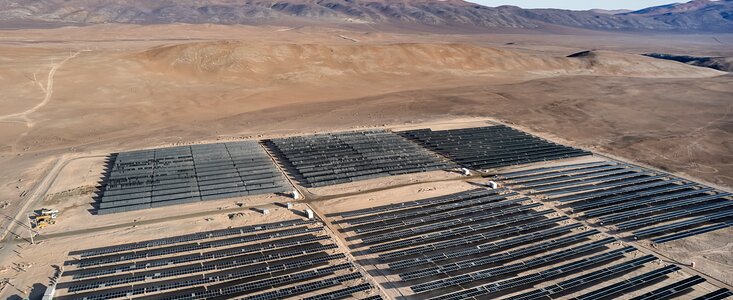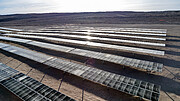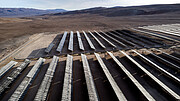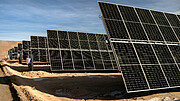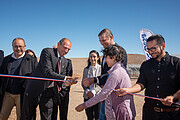Mededeling
ESO’s Paranal Observatory starts receiving energy from the largest solar plant in Chile dedicated to astronomy
The emission of 1700 tons of CO2 will be avoided per year for the operation of ESO's VLT and ELT.
12 juli 2022
After nine months of work, ESO and the Saesa Group inaugurated the Paranal-Armazones photovoltaic plant, which will supply renewable energy to ESO's Paranal Observatory and, soon, to the construction and operation of ESO's Extremely Large Telescope (ELT), the largest optical telescope in the world.
After its inauguration, the plant became the largest solar complex in Chile supplying renewable energy to an astronomical observatory. With 18 565 panels, distributed over 7.2 hectares of land, it will harvest 9 megawatts of electric power. This will make it possible to cover 100% of the energy needed to operate ESO’s facilities, such as the Very Large Telescope and the ELT, during a day, the period with the greatest energy demand due to the telescopes’ cooling systems.
“This milestone is a dream that becomes reality! Today we are closing an endeavour that started more than ten years ago, when the Chilean Ministry of Energy together with the National Energy Commission engaged to help ESO in looking for the best available options to generate and supply clean energy to the biggest telescope in the world,” said ESO’s ELT Programme Manager Roberto Tamai during the plant’s inauguration ceremony, which gathered authorities with members of Saesa Group and ESO.
“We are very happy to expand our presence in Antofagasta, supplying renewable energy to ESO's ELT and, at the same time, injecting clean energy into the system. For years we have been providing clean, efficient, and reliable energy solutions to the southern regions, so offering them to the north of the country is a source of pride and motivation for us and we can continue contributing to the decontamination of cities and the improvement of quality of people's lives. By operating this plant, which will be very important for the development of national astronomy, we are contributing another small grain of sand to achieve the carbon neutrality that Chile has proposed”, said Francisco Alliende, general manager of the Saesa Group.
Energy consumption represents one of ESO's largest sources of CO2 emissions. However, the emission of 1700 tons of CO2 per year, will be avoided thanks to the power plant, which is located 130 km south of Antofagasta in Chile’s Atacama Desert and is a key part of ESO's strategic sustainability plan.
“The opening of this photovoltaic plant is a milestone because it connects and boosts the activities we want for the country we are trying to build: science, astronomy, and clean energy. From the Atacama Desert, we will learn about the origins of the Universe, promoting climate action to face the challenge of climate change," said Maisa Rojas, Minister for the Environment of Chile.
This new plant will also contribute solar energy to the country's energy system. Thanks to the Armazones substation and its transmission lines, all the energy not used in scientific operations will be injected into the Chilean energy grid.
“The scientific infrastructure must be at the service of society. This also implies actively taking on the current challenges in matters of sustainability. This plant brings us one step closer to the development of science in a way that is friendly to the environment”, said Luis Chavarría, ESO representative in Chile, during the ceremony.
“We are grateful for ESO's commitment to the region, which is reflected by changing their energy matrix to a 100% clean and renewable supply. These projects are aligned with Chilean President Gabriel Boric's Ecological Government's objective, as well as the Climate Change Framework Law. Therefore, the solar matrix that will supply clean energy to the Observatory is noteworthy, as it contributes to the country's goal of being carbon neutral by 2050,” said Dafne Pino, Ministerial Regional Secretary of Energy in Antofagasta.
The photovoltaic complex has state-of-the-art technology to efficiently collect the photons emitted by the Sun. It has double-sided panels capable of generating electricity from direct sunlight and light reflected by the ground of the Atacama Desert. Additionally, the panels were installed in such a way that they can automatically rotate to follow the apparent movement of the Sun in the sky. This optimises power generation until the last seconds of the day.
The plant, the substation and the transmission lines are owned and operated by the Saesa Group. ESO provided the land use, along with administrative and legal support to bring the project to fruition.
Links
- ESO adopting new measures to improve its environmental sustainability
- ESO's Extremely Large Telescope will be powered by a solar plant
Contact
Francisco Rodríguez
ESO Press Officer Chile
Santiago, Chile
Email: francisco.rodriguez@eso.org
Soledad Neumann
Líder Reputación Corporativa
Grupo Saesa
Tel: +56 961701884
Email: soledad.neumann@saesa.cl
Over de Mededeling
| Id: | ann22010 |
Our use of Cookies
We use cookies that are essential for accessing our websites and using our services. We also use cookies to analyse, measure and improve our websites’ performance, to enable content sharing via social media and to display media content hosted on third-party platforms.
ESO Cookies Policy
The European Organisation for Astronomical Research in the Southern Hemisphere (ESO) is the pre-eminent intergovernmental science and technology organisation in astronomy. It carries out an ambitious programme focused on the design, construction and operation of powerful ground-based observing facilities for astronomy.
This Cookies Policy is intended to provide clarity by outlining the cookies used on the ESO public websites, their functions, the options you have for controlling them, and the ways you can contact us for additional details.
What are cookies?
Cookies are small pieces of data stored on your device by websites you visit. They serve various purposes, such as remembering login credentials and preferences and enhance your browsing experience.
Categories of cookies we use
Essential cookies (always active): These cookies are strictly necessary for the proper functioning of our website. Without these cookies, the website cannot operate correctly, and certain services, such as logging in or accessing secure areas, may not be available; because they are essential for the website’s operation, they cannot be disabled.
Functional Cookies: These cookies enhance your browsing experience by enabling additional features and personalization, such as remembering your preferences and settings. While not strictly necessary for the website to function, they improve usability and convenience; these cookies are only placed if you provide your consent.
Analytics cookies: These cookies collect information about how visitors interact with our website, such as which pages are visited most often and how users navigate the site. This data helps us improve website performance, optimize content, and enhance the user experience; these cookies are only placed if you provide your consent. We use the following analytics cookies.
Matomo Cookies:
This website uses Matomo (formerly Piwik), an open source software which enables the statistical analysis of website visits. Matomo uses cookies (text files) which are saved on your computer and which allow us to analyze how you use our website. The website user information generated by the cookies will only be saved on the servers of our IT Department. We use this information to analyze www.eso.org visits and to prepare reports on website activities. These data will not be disclosed to third parties.
On behalf of ESO, Matomo will use this information for the purpose of evaluating your use of the website, compiling reports on website activity and providing other services relating to website activity and internet usage.
Matomo cookies settings:
Additional Third-party cookies on ESO websites: some of our pages display content from external providers, e.g. YouTube.
Such third-party services are outside of ESO control and may, at any time, change their terms of service, use of cookies, etc.
YouTube: Some videos on the ESO website are embedded from ESO’s official YouTube channel. We have enabled YouTube’s privacy-enhanced mode, meaning that no cookies are set unless the user actively clicks on the video to play it. Additionally, in this mode, YouTube does not store any personally identifiable cookie data for embedded video playbacks. For more details, please refer to YouTube’s embedding videos information page.
Cookies can also be classified based on the following elements.
Regarding the domain, there are:
- First-party cookies, set by the website you are currently visiting. They are stored by the same domain that you are browsing and are used to enhance your experience on that site;
- Third-party cookies, set by a domain other than the one you are currently visiting.
As for their duration, cookies can be:
- Browser-session cookies, which are deleted when the user closes the browser;
- Stored cookies, which stay on the user's device for a predetermined period of time.
How to manage cookies
Cookie settings: You can modify your cookie choices for the ESO webpages at any time by clicking on the link Cookie settings at the bottom of any page.
In your browser: If you wish to delete cookies or instruct your browser to delete or block cookies by default, please visit the help pages of your browser:
Please be aware that if you delete or decline cookies, certain functionalities of our website may be not be available and your browsing experience may be affected.
You can set most browsers to prevent any cookies being placed on your device, but you may then have to manually adjust some preferences every time you visit a site/page. And some services and functionalities may not work properly at all (e.g. profile logging-in, shop check out).
Updates to the ESO Cookies Policy
The ESO Cookies Policy may be subject to future updates, which will be made available on this page.
Additional information
For any queries related to cookies, please contact: pdprATesoDOTorg.
As ESO public webpages are managed by our Department of Communication, your questions will be dealt with the support of the said Department.
